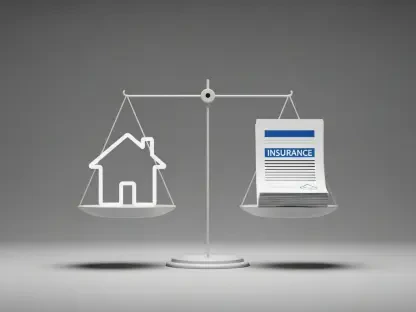Africa faces a daunting financial challenge with an insurance protection gap that leaves millions exposed to catastrophic losses from disasters, health crises, or sudden income disruptions, a situation made stark by insurance penetration rates hovering below 3% of GDP. This figure, significantly lower than global averages, contributes to a worldwide shortfall of $1.8 trillion between insured and uninsured losses across critical sectors like health, life, agriculture, and natural catastrophes. The vulnerability of households and small businesses is palpable, as a single unforeseen event can erase livelihoods overnight. Yet, amidst this crisis lies a profound opportunity. Industry experts argue that cutting-edge technology, including artificial intelligence (AI) and data analytics, holds the potential to revolutionize the insurance landscape on the continent. By leveraging these tools, insurers can address systemic barriers, tailor solutions to local needs, and build resilient financial systems that protect the most vulnerable populations while unlocking new commercial prospects.
Technological Innovations Driving Change
Harnessing AI and Data Analytics
The advent of AI and machine learning has opened new frontiers for insurers in Africa, particularly in the realm of risk assessment, where traditional methods often falter due to limited historical data. These technologies enable the processing of vast and varied datasets, including geospatial climate models and real-time consumer behavior, to deliver precise risk evaluations. This capability is transformative in a region where data scarcity has long hindered accurate pricing and product development. By integrating advanced analytics, insurers can craft offerings that reflect the true risks faced by African communities, whether it’s a farmer grappling with drought or a small business navigating economic volatility. Such precision not only enhances affordability but also ensures that coverage is relevant to the lived realities of the population, paving the way for broader adoption across diverse markets.
Beyond risk assessment, synthetic data generation emerges as a critical tool in creating equitable pricing models tailored to Africa’s unique economic landscape. In environments where conventional data is sparse or unreliable, synthetic data—artificially created yet representative of real-world patterns—fills the gap, allowing insurers to simulate scenarios and test pricing strategies without compromising fairness. This approach mitigates the risk of overcharging or underinsuring, which has historically alienated potential customers. Furthermore, it supports the design of innovative products that cater to niche needs, such as microinsurance for low-income households. As insurers harness these analytical advancements, the potential to scale solutions and penetrate underserved markets grows, offering a glimpse of a future where financial protection is no longer a luxury but a fundamental right for all.
Parametric Insurance as a Game-Changer
Parametric insurance stands out as a revolutionary approach to addressing the pressing climate and agricultural risks that dominate Africa’s risk profile, particularly in rural areas where traditional coverage models often fail. Unlike conventional policies that require lengthy claims assessments, parametric insurance triggers payouts based on predefined, measurable events such as specific rainfall levels or temperature thresholds. This simplicity is a boon for regions vulnerable to droughts or floods, as it ensures rapid financial relief when disaster strikes. For farmers and smallholders, who form a significant portion of the continent’s population, this model offers a lifeline, protecting against crop failures without the burden of complex documentation or delayed settlements, thus aligning with the urgent needs of communities on the frontlines of climate change.
Equally important is how parametric insurance simplifies access for underserved populations unfamiliar with traditional insurance mechanisms. Its straightforward design—where payouts are automatic once triggers are met—reduces the intimidation factor often associated with financial products. This accessibility is crucial on a continent where literacy rates and trust in formal systems vary widely. By minimizing bureaucratic hurdles and accelerating payouts, parametric models build confidence among first-time users, encouraging uptake in remote and marginalized areas. Additionally, the integration of technology, such as satellite data for monitoring weather events, enhances the reliability of these products, ensuring that payouts are both timely and accurate. This innovation marks a significant step toward inclusive financial protection across diverse African demographics.
Building Trust and Accessibility
Overcoming Consumer Distrust
One of the most formidable barriers to insurance adoption in Africa is the deep-seated consumer distrust stemming from historical perceptions of poor value and opaque practices, a challenge acknowledged by 77% of global executives in a recent industry survey. Technology offers a pathway to mend this rift through personalized engagement, leveraging tools like natural language processing and generative AI to create interactions that resonate on a cultural and individual level. These advancements enable insurers to communicate in local languages and address specific concerns, fostering a sense of connection akin to community-based brokers of the past. By tailoring outreach and education efforts, insurers can demystify their offerings, turning skepticism into understanding and paving the way for stronger customer relationships.
Beyond personalization, transparency and operational efficiency play pivotal roles in rebuilding credibility within the insurance sector. Unified decision-making platforms, which integrate data analytics and customer engagement, streamline processes such as claims handling and fraud detection, addressing long-standing grievances about delays and unreliability. When claims are processed swiftly and fairly, perceptions of insurance as a distant or untrustworthy service begin to shift. Moreover, by reducing fraudulent activities through sophisticated algorithms, these platforms ensure that resources are directed to genuine policyholders, enhancing overall trust. Such technological interventions are not mere conveniences but essential steps in transforming how African consumers view and interact with insurance providers, setting a foundation for sustained growth in penetration rates.
Expanding Reach with Mobile-First Solutions
Africa’s high mobile penetration provides fertile ground for expanding insurance access through mobile-first distribution channels and embedded insurance models, which integrate coverage into everyday transactions. With smartphones ubiquitous even in remote areas, insurers can deliver products directly to users via mobile apps or text-based services, bypassing traditional barriers like physical branches or complex paperwork. This approach capitalizes on the continent’s digital leap, where mobile technology often outpaces other infrastructure. By embedding insurance into routine activities—such as purchasing airtime or paying bills—providers make coverage feel less like a separate commitment and more like a seamless part of daily life, significantly lowering the entry threshold for first-time users.
Evidence of this strategy’s success is already visible in regional models across countries like Kenya, Nigeria, and South Africa, where partnerships between insurers, telecoms, and fintechs have driven remarkable uptake. These collaborations leverage existing customer bases and trusted platforms to introduce insurance products, often bundled with other services, making them more approachable and relevant. For instance, microinsurance tied to mobile money accounts has enabled low-income individuals to access protection against specific risks at minimal cost. Such initiatives not only boost accessibility but also demonstrate the power of integrating financial services into familiar ecosystems. As these models scale, they offer a blueprint for reaching millions more, ensuring that insurance becomes a practical tool for financial resilience across diverse African contexts.
The Need for Collaboration
Uniting Stakeholders for Impact
Addressing Africa’s insurance protection gap is a challenge too vast for any single entity to tackle alone, necessitating robust collaboration among insurers, governments, regulators, and other stakeholders to drive systemic change. Cross-sector partnerships are vital for scaling solutions, whether through policy reforms that incentivize innovation or public-private initiatives that fund technology adoption. Governments can play a key role by creating enabling environments—such as subsidies for parametric insurance in agriculture—while regulators ensure consumer protections keep pace with digital advancements. Insurers, in turn, must align their strategies with broader societal goals, ensuring that efforts to close the gap are both impactful and sustainable. This collective approach amplifies the reach and effectiveness of technological solutions, turning isolated efforts into a cohesive movement for financial inclusion.
A shared commitment to inclusion underpins these collaborative efforts, focusing on affordability, ethical practices, and long-term value delivery to communities. Stakeholders must prioritize products that meet genuine needs without exploiting vulnerable populations, balancing commercial objectives with social impact. This means designing policies with transparent terms and ensuring claims are honored promptly, which builds confidence in the system. Additionally, educational campaigns supported by multiple sectors can raise awareness about the benefits of insurance, particularly in rural or low-literacy areas. By aligning on these principles, partnerships can create a virtuous cycle where increased trust drives demand, which in turn fuels further innovation and investment, ultimately reshaping the insurance landscape for the better across the continent.
Drawing on Global Best Practices
While Africa’s insurance challenges are unique, the continent can benefit immensely from adapting global best practices in data analytics, AI, and cloud computing to local contexts, ensuring solutions are both cutting-edge and culturally relevant. Technologies like real-time data processing, already proven in other regions, can be tailored to monitor climate risks or customer trends specific to African markets. Cloud-based platforms, meanwhile, offer scalability, allowing insurers to expand operations without prohibitive infrastructure costs. By learning from global successes—such as mobile payment systems that have thrived locally—insurers can leapfrog outdated models, adopting agile, tech-driven approaches that align with the continent’s digital trajectory. This blend of innovation and adaptation is key to accelerating progress in closing the protection gap.
Balancing profit with purpose remains a critical consideration in this process, as sustainable inclusion demands that commercial goals do not overshadow the ethical imperative to deliver tangible value. Insurers must focus on long-term strategies that prioritize customer welfare, such as affordable premiums and reliable payouts, over short-term gains. Drawing on international frameworks for ethical data use can also guide the responsible application of AI, ensuring privacy and fairness in customer interactions. As Africa integrates these global insights, the emphasis must remain on creating systems that empower communities, providing not just financial protection but also a sense of security and trust. Reflecting on past efforts, stakeholders recognized that only through such balanced, collaborative, and principled approaches did meaningful strides emerge in transforming the continent’s insurance ecosystem.









